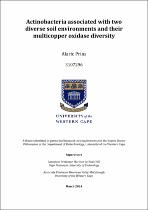| dc.description.abstract | The Cape Floristic Region (CFR) is a biodiverse region boasting unique plant diversity with a rich concentration of endemic plants. Aspalathus linearis (Rooibos) is an indigenous plant that grows in the Clanwilliam region of the Western Cape and is cultivated for its use as an herbal tea. Emerging peatlands in the CFR have gained increasing attention over recent years through research aiming to understand the microbial diversity associated with these environments. Little is known about the actinobacterial diversity of these regions, and as such, it is necessary to investigate the diversity of the actinobacteria associated with these environments, whilst simultaneously gaining knowledge on whether the associated actinobacteria may produce enzymes of biotechnological interest. Two CFR regions (the Rooibos environment – Clanwillian, and the Springfield emerging peatland environment – Agulhas) were explored through culture-based and genomic screening. Metabarcoding analyses using actinobacterial-specific 16S rRNA gene primers showed that the major taxa contributing to the Rooibos environment were members of the families Mycobacteriaceae, Pseudonocardiaceae, Frankiaceae and Geodermatophilaceae. Members of the families Mycobacteriaceaea, Pseudonocardiaceae, Acidimicrobiaceae and Nocardioiaceae was identified as the major taxa for the Springfield environment. Through selective isolation techniques, actinobacteria from rare (underrepresented) genera were isolated, including members of the genera Dactylosporangium, Actinokineospora, Curtobacterium, Modestobacter, Leifsonia and Actinomadura. The top strains, selected based on exhibiting extracellular multicopper oxidase (MCO) activity through culture-based screening, were subjected to whole genome sequence analysis. These rare genera are also vastly underrepresented among 3 400 bacterial MCO sequences found in the Laccase and Multicopper Oxidase Engineering Database (LccED). | en_US |

